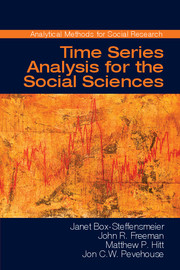Book contents
- Frontmatter
- Dedication
- Contents
- Preface
- 1 Modeling Social Dynamics
- 2 Univariate Time Series Models
- 3 Dynamic Regression Models
- 4 Modeling the Dynamics of Social Systems
- 5 Univariate, Nonstationary Processes: Tests and Modeling
- 6 Cointegration and Error Correction Models
- 7 Selections on Time Series Analysis
- 8 Concluding Thoughts for the Time Series Analyst
- Appendix Time Series Models as Difference Equations
- Bibliography
- Index
Appendix - Time Series Models as Difference Equations
Published online by Cambridge University Press: 05 December 2014
- Frontmatter
- Dedication
- Contents
- Preface
- 1 Modeling Social Dynamics
- 2 Univariate Time Series Models
- 3 Dynamic Regression Models
- 4 Modeling the Dynamics of Social Systems
- 5 Univariate, Nonstationary Processes: Tests and Modeling
- 6 Cointegration and Error Correction Models
- 7 Selections on Time Series Analysis
- 8 Concluding Thoughts for the Time Series Analyst
- Appendix Time Series Models as Difference Equations
- Bibliography
- Index
Summary
INTRODUCTION
The material in this appendix is aimed at readers interested in the mathematical underpinnings of time series models. As with any statistical method, one can estimate time series models without such foundational knowledge. But the material here is critical for any reader who is interested in going beyond applying existing “off the shelf” models and conducting research in time series methodology.
Many social theories are formulated in terms of changes in time. We conceptualize social processes as mixes of time functions. In so doing, we use terms such as trend and cycle. A trend usually is a function of the form α × t where α is a constant and t is a time counter, a series of natural numbers that represents successive time points. When α is positive (negative), the trend is steadily increasing (decreasing). The time function sin αt could be used to represent asocial cycle, as could a positive constant times a negative integer raised to the time counter: α(−1)t. In addition, we argue that social processes experience sequences of random shocks and make assumptions about the distributions from which these shocks are drawn. For instance, we often assume that processes repeatedly experience a shock, ∈t, drawn independently across time from a normal distribution with mean zero and unit variance.
Social processes presumably are a combination of these trends, cycles, and shocks.
- Type
- Chapter
- Information
- Time Series Analysis for the Social Sciences , pp. 219 - 262Publisher: Cambridge University PressPrint publication year: 2014

